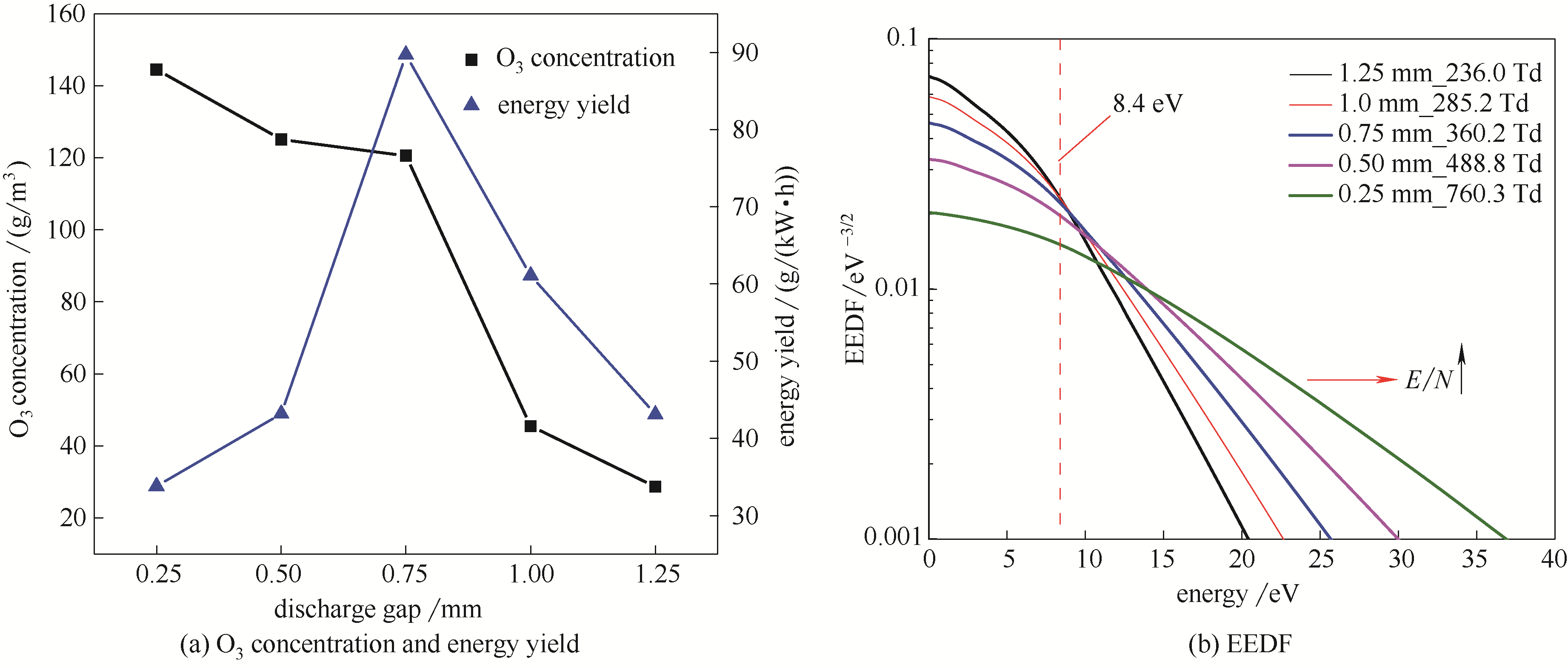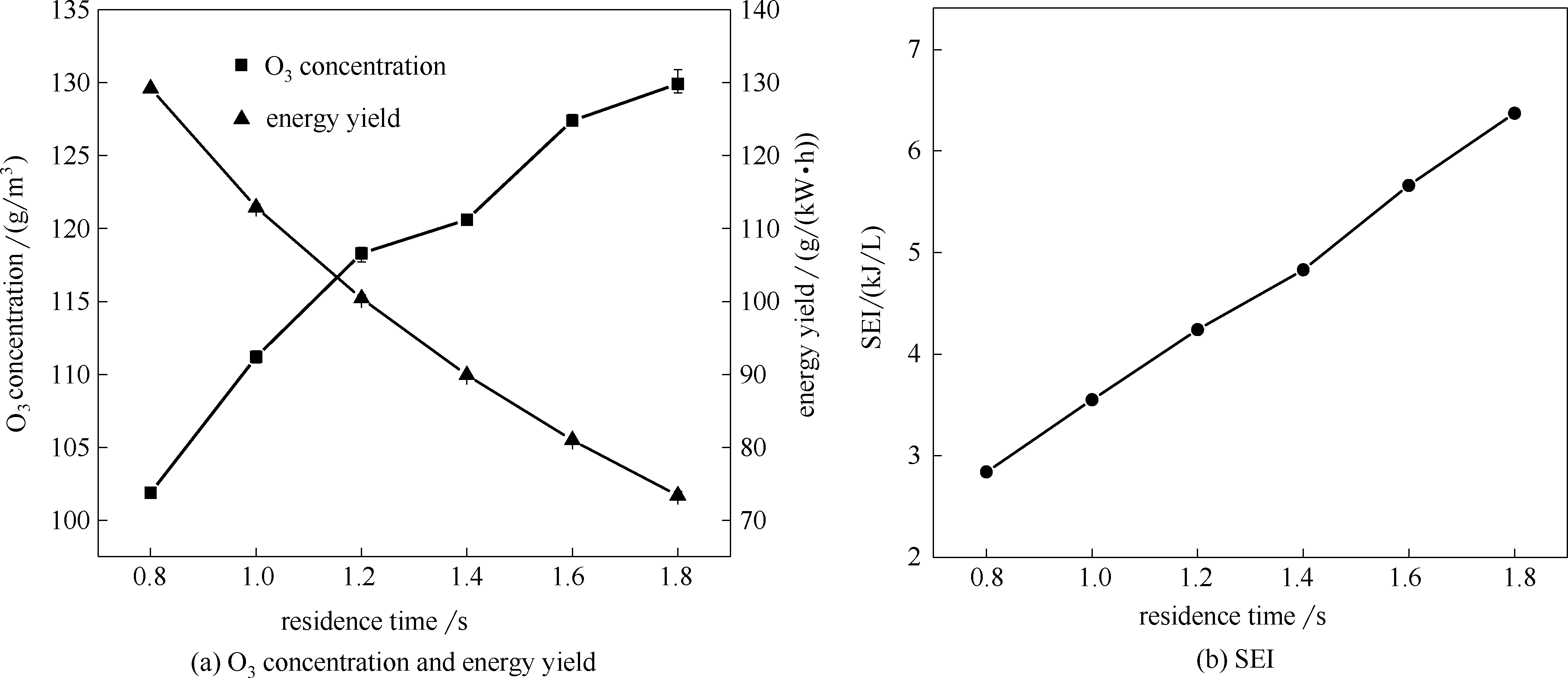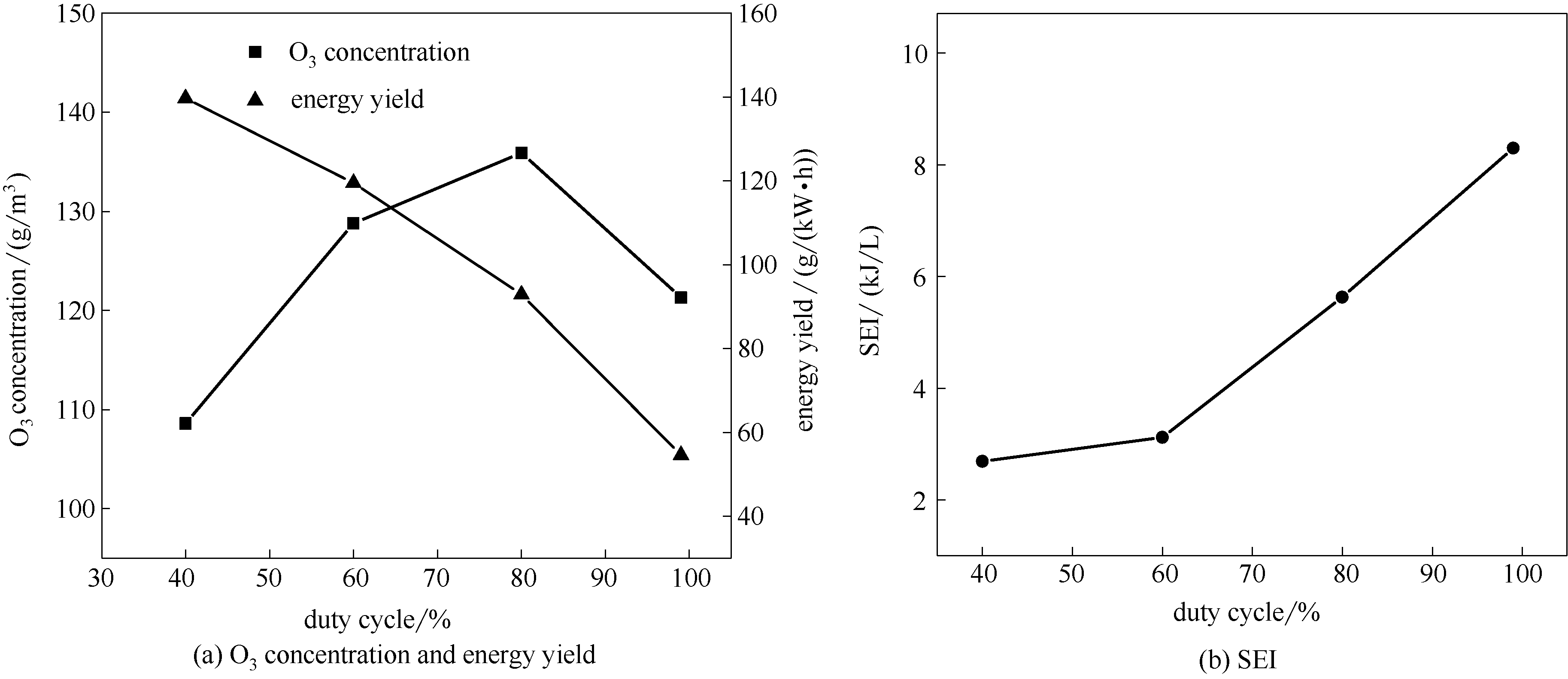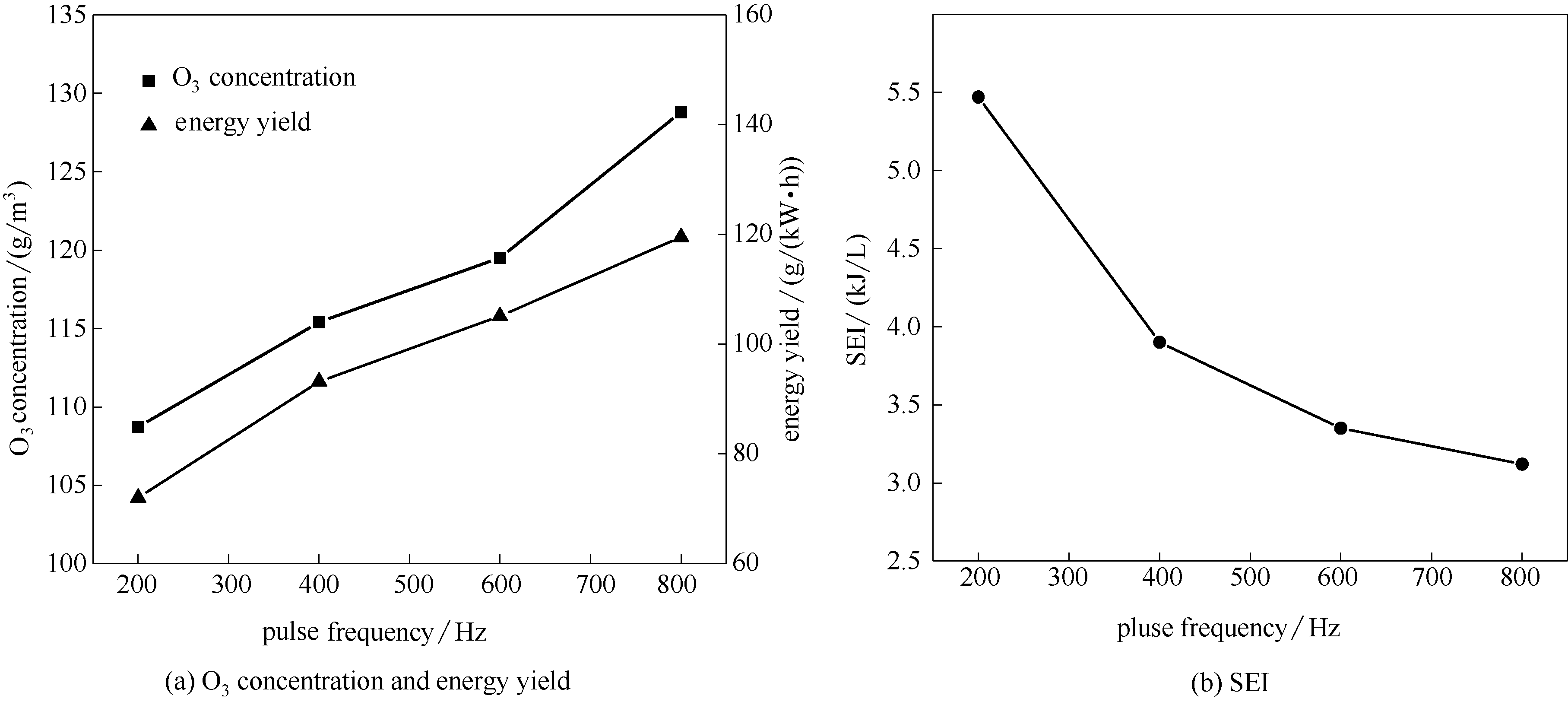化工学报 ›› 2020, Vol. 71 ›› Issue (2): 746-754.DOI: 10.11949/0438-1157.20191068
收稿日期:2019-09-23
修回日期:2019-11-28
出版日期:2020-02-05
发布日期:2020-02-05
通讯作者:
王保伟
作者简介:王保伟(1971—),男,博士,副教授,基金资助:
Baowei WANG( ),Huijuan SU,Shumei YAO
),Huijuan SU,Shumei YAO
Received:2019-09-23
Revised:2019-11-28
Online:2020-02-05
Published:2020-02-05
Contact:
Baowei WANG
摘要:
介质阻挡放电(DBD)是工业生产臭氧(O3)最有效的方法。研究以O2为原料气采用DBD微等离子体放电制备O3,研究了放电间距、放电长度、放电功率以及停留时间对产生O3的影响。此外,通过向正弦AC等离子体电源中叠加调制脉冲,探讨了脉冲占空比与调制频率对O3生成的影响。结果表明:O3浓度与DBD反应器的放电间距呈负相关,与O2的停留时间呈正相关,放电功率及有效放电长度对O3浓度的影响呈现火山形变化趋势。综合考虑O3浓度及能量产率确定了适宜的参数。与普通正弦交流电源相比,在其基础上叠加脉冲调制电源有利于O3的产生,而能量产率与占空比呈正相关,与调制频率呈负相关,据此确定了合适的占空比与调制频率。
中图分类号:
王保伟, 苏会娟, 姚淑美. O2介质阻挡放电微等离子体制备O3[J]. 化工学报, 2020, 71(2): 746-754.
Baowei WANG, Huijuan SU, Shumei YAO. Preparation of O3 by O2 DBD microplasma[J]. CIESC Journal, 2020, 71(2): 746-754.

图4 放电间距对臭氧产生性能及电子能量分布的影响
Fig.4 Effect of discharge gap on O3 production performance and electron energy distribution(discharge length: 80 mm; supply frequency: 18 kHz; Pdis: (6.7 ± 0.2) W; residence time: 1.4 s)
| Discharge gap/mm | (E/N)/Td | Mean electron energy/eV |
|---|---|---|
| 0.25 | 760.3 | 16.2 |
| 0.5 | 488.8 | 11.7 |
| 0.75 | 360.2 | 9.38 |
| 1 | 285.2 | 7.93 |
| 1.25 | 236 | 6.96 |
表1 放电间距对应的折合电场强度及平均电子能量
Table 1 E/N and mean electron energy at different discharge gap
| Discharge gap/mm | (E/N)/Td | Mean electron energy/eV |
|---|---|---|
| 0.25 | 760.3 | 16.2 |
| 0.5 | 488.8 | 11.7 |
| 0.75 | 360.2 | 9.38 |
| 1 | 285.2 | 7.93 |
| 1.25 | 236 | 6.96 |

图5 放电长度对臭氧产生性能的影响
Fig.5 Effect of discharge length on O3 production performance(discharge gap: 0.75 mm; supply frequency: 18 kHz; Pdis: (6.7 ± 0.2) W; residence time: 1.4 s)

图6 放电功率对臭氧浓度及能量产率的影响
Fig.6 Effect of discharge power on O3 concentration and energy yield (discharge length: 80 mm; discharge gap: 0.75 mm; supply frequency: 18 kHz; residence time: 1.4 s)
| Discharge power/W | (E/N)/Td | Mean electron energy/eV |
|---|---|---|
| 5 | 328.9 | 8.78 |
| 6.7 | 360.2 | 9.38 |
| 7.9 | 383.7 | 9.83 |
| 9.3 | 415 | 10.4 |
| 10.7 | 430.7 | 10.7 |
| 12.9 | 446.3 | 11 |
表2 放电功率对应的折合电场强度及平均电子能量
Table 2 E/N and mean electron energy at different discharge power
| Discharge power/W | (E/N)/Td | Mean electron energy/eV |
|---|---|---|
| 5 | 328.9 | 8.78 |
| 6.7 | 360.2 | 9.38 |
| 7.9 | 383.7 | 9.83 |
| 9.3 | 415 | 10.4 |
| 10.7 | 430.7 | 10.7 |
| 12.9 | 446.3 | 11 |

图7 放电功率对电子能量分布及反应器温度、能量密度的影响
Fig.7 Effect of discharge power on reactor temperature, SEI and EEDF(discharge length: 80 mm; discharge gap: 0.75 mm; supply frequency: 18 kHz; residence time: 1.4 s)

图8 停留时间对臭氧产生性能的影响
Fig.8 Effect of residence time on O3 production performance concentration and energy yield(discharge gap: 0.75 mm; discharge length: 80 mm; Pdis: (6.7 ± 0.2) W; supply frequency: 18 kHz)

图9 调制脉冲占空比对臭氧产生及SEI的影响
Fig.9 Effect of duty cycle of modulated pulse on O3 generation and SEI (discharge gap: 0.75 mm; discharge length: 80 mm; Pdis: (6.7 ± 0.2) W, residence time: 1.4 s; supply frequency: 18 kHz; modulation frequency: 800 Hz)

图10 调制脉冲频率对臭氧产生及SEI的影响
Fig.10 Effect of modulation frequency on O3 generation and SEI(discharge gap: 0.75 mm; discharge length: 80 mm; Pdis: (6.7 ± 0.2) W; residence time: 1.4 s; supply frequency: 18 kHz; duty cycle: 60%)
| 1 | 王保伟, 姚淑美, 彭叶平. 介质阻挡等离子体制备臭氧研究进展[J]. 现代化工, 2018, 38(7): 31-35. |
| Wang B W, Yao S M, Peng Y P. Progress on preparation of ozone by dielectric barrier plasma[J]. Modern Chemical Industry, 2018, 38(7): 31-35. | |
| 2 | Nassour K, Brahami M, Nemmich S, et al. Comparative experimental study between surface and volume DBD ozone generator[J]. Ozone: Science & Engineering, 2015, 38: 70-76. |
| 3 | Jenei I, Kis P, Kiss E. The development of ozone generators with the analysis of the field distribution of the electrode arrangements[J]. Ozone: Science & Engineering, 2007, 29: 215-220. |
| 4 | Zhang X, Lee B J, Hong G I, et al. Ozone production with dielectric barrier discharge-effects of power source and humidity[J]. IEEE Transactions on Plasma Science, 2016, 44(10): 2288-2296. |
| 5 | Wei L S. Dong G P, Zhang Y F,et al. Effect of SF6 on ozone generation using dielectric barrier discharge [J]. High Voltage Engineering, 2013, 39(10): 2520-2525. |
| 6 | 魏林生. 等离子体臭氧产生的实验与理论研究[D]. 杭州: 浙江大学, 2008. |
| Wei L S. Theoretical and experimental research on ozone generation by gas discharge plasma[D].Hangzhou: Zhejiang University, 2008. | |
| 7 | Wei L S, Yuan D, Zhang Y, et al. An analysis of the effect of inert gases on ozone generation using dielectric barrier discharge in oxygen [J]. The European Physical Journal D, 2014, 68(1): 17. |
| 8 | Wei L S, Yuan D, Zhang Y, et al. The effect of inert gases on ozone generation using dielectric barrier discharge in dry air [J]. Ozone: Science & Engineering, 2013, 35(6): 448-455. |
| 9 | Chen H L, Lee H M, Chen S H, et al. Influence of Ar addition on ozone generation in nonthermal plasmas [J]. Plasma Sources Science and Technology, 2010, 19(6): 692-701. |
| 10 | Pekárek S. Asymmetric properties and ozone production of surface dielectric barrier discharge with different electrode configurations [J]. The European Physical Journal D, 2013, 67(5): 94. |
| 11 | Nassour K, Brahami M, Nemmich S, et al. New hybrid surface-volume dielectric barrier discharge reactor for ozone generation [J]. IEEE Transactions on Industry Applications, 2017, 53(3): 2477-2484. |
| 12 | Malik M A, Schoenbach K H, Heller R. Coupled surface dielectric barrier discharge reactor-ozone synthesis and nitric oxide conversion from air [J]. Chemical Engineering Journal, 2014, 256: 222-229. |
| 13 | Chebbah A, Hadjeri S, Nemmich S, et al. Development and experimental analysis of a new “serpentine-shape” surface-DBD ozone generator — comparison with a cylindrical volume-DBD ozone generator [J]. Ozone: Science & Engineering, 2017, 39(3): 209-216. |
| 14 | Andreev V V, Pichugin Y P, Telegin V G, et al. Combined barrier discharge in atmospheric-pressure air [J]. Plasma Physics Reports, 2012, 38(13): 1046-1049. |
| 15 | Jodpimai S, Boonduang S, Limsuwan P. Dielectric barrier discharge ozone generator using aluminum granules electrodes [J]. Journal of Electrostatics, 2015, 74: 108-114. |
| 16 | Gnapowski S, Yamabe C, Ihara S. Ozone generation characteristics of ozonizer with the rotating type electrode [J]. IEEJ Transactions on Fundamentals and Materials, 2008, 128(10): 619-623. |
| 17 | Zhang Z, Bai X, Bai M, et al. An ozone generator of miniaturization and modularization with the narrow discharge gap[J]. Plasma Chemistry and Plasma Processing, 2003, 23(3): 559-568. |
| 18 | 商克峰, 曹晓萌, 王肖静, 等. 高压电极构型对DBD装置放电特性及臭氧生成的影响[J]. 高电压技术, 2016, 42(5): 1394-1400. |
| Shang K F, Cao X M, Wang X J, et al. Effect of high voltage electrode geometry on the discharge characteristics and the ozone generation of a DBD device[J]. High Voltage Engineering, 2016, 42(5): 1394-1400. | |
| 19 | 杨春, 胡兆吉, 魏林生. 放电等离子体臭氧发生技术研究现状与进展[J]. 高压电器, 2010, 46: 78-85. |
| Yang C, Hu Z J, Wei L S. The research development of plasma discharge synthesis technology of ozone [J]. High Voltage Apparatus, 2010, 46: 78-85. | |
| 20 | 周立福, 杨学昌, 陈波, 等. 臭氧发生器用高介电硅橡胶复合材料特性及试验分析[J]. 高电压技术, 2010, 36: 1258-1263. |
| Zhou L F, Yang X C, Chen B, et al. Characteristics and experimental analysis of High-K MVQ functional composites for ozonizer [J]. High Voltage Engineering, 2010, 36: 1258-1263. | |
| 21 | 陈波, 杨学昌, 陶顺忠. 等离子喷涂介质层提升臭氧发生器性能的试验研究[J]. 高电压技术, 2013, 39: 1703-1709. |
| Chen B, Yang X C, Tao S Z. Experimental study on plasma sprayed dielectric layer to improve ozone performance [J]. High Voltage Engineering, 2013, 39: 1703-1709. | |
| 22 | 王健. 催化剂耦合介质阻挡放电制取臭氧的试验和模型研究[D]. 合肥: 中国科学技术大学, 2009. |
| Wang J. Experimental and model study of ozone production via DBDs coupling with catalyst[D].Hefei: University of Science and Technology of China, 2009. | |
| 23 | Pekarek S, Mikes J, Pelikanova I B, et al. Effect of TiO2 on various regions of active electrode on surface dielectric barrier discharge in air [J]. Plasma Chemistry and Plasma Processing, 2016, 36(5): 1187-1200. |
| 24 | Pekárek S. Experimental study of surface dielectric barrier discharge in air and its ozone production [J]. Journal of Physics D: Applied Physics, 2012, 45(7): 075201. |
| 25 | Huang W, Ren T, Xia W. Ozone generation by hybrid discharge combined with catalysis [J]. Ozone: Science & Engineering, 2007, 29(2): 107-112. |
| 26 | Dwivedi C, Toley M A, Dey G R, et al. Ozone generation from argon-oxygen mixtures in presence of different packing materials within dielectric barrier discharge gap [J]. Ozone: Science & Engineering, 2013, 35(2): 134-145. |
| 27 | database Phelps [EB/OL]. 2018-06-04, https: //fr.lxcat.net/data/set_type.php. |
| 28 | Yagi S, Kuzumoto M.Silent discharges in ozonisers and CO2 lasers[J]. Australian Journal of Physics, 1995, 48: 411-418. |
| 29 | Homola T, Pongrác B, Zemánek M, et al. Efficiency of ozone production in coplanar dielectric barrier discharge[J]. Plasma Chemistry and Plasma Processing, 2019, 39: 1227-1242. |
| 30 | 邵涛, 严萍.大气压气体放电及其等离子体应用[M].北京: 科学出版社, 2015. |
| Shao T, Yan P. Atmospheric Pressure Gas Discharge and Its Plasma Application[M]. Beijing: Science Press, 2015. |
| [1] | 张义飞, 刘舫辰, 张双星, 杜文静. 超临界二氧化碳用印刷电路板式换热器性能分析[J]. 化工学报, 2023, 74(S1): 183-190. |
| [2] | 胡超, 董玉明, 张伟, 张红玲, 周鹏, 徐红彬. 浓硫酸活化五氧化二钒制备高浓度全钒液流电池正极电解液[J]. 化工学报, 2023, 74(S1): 338-345. |
| [3] | 宋瑞涛, 王派, 王云鹏, 李敏霞, 党超镔, 陈振国, 童欢, 周佳琦. 二氧化碳直接蒸发冰场排管内流动沸腾换热数值模拟分析[J]. 化工学报, 2023, 74(S1): 96-103. |
| [4] | 米泽豪, 花儿. 基于DFT和COSMO-RS理论研究多元胺型离子液体吸收SO2气体[J]. 化工学报, 2023, 74(9): 3681-3696. |
| [5] | 范孝雄, 郝丽芳, 范垂钢, 李松庚. LaMnO3/生物炭催化剂低温NH3-SCR催化脱硝性能研究[J]. 化工学报, 2023, 74(9): 3821-3830. |
| [6] | 杨百玉, 寇悦, 姜峻韬, 詹亚力, 王庆宏, 陈春茂. 炼化碱渣湿式氧化预处理过程DOM的化学转化特征[J]. 化工学报, 2023, 74(9): 3912-3920. |
| [7] | 陈美思, 陈威达, 李鑫垚, 李尚予, 吴有庭, 张锋, 张志炳. 硅基离子液体微颗粒强化气体捕集与转化的研究进展[J]. 化工学报, 2023, 74(9): 3628-3639. |
| [8] | 程业品, 胡达清, 徐奕莎, 刘华彦, 卢晗锋, 崔国凯. 离子液体基低共熔溶剂在转化CO2中的应用[J]. 化工学报, 2023, 74(9): 3640-3653. |
| [9] | 陈哲文, 魏俊杰, 张玉明. 超临界水煤气化耦合SOFC发电系统集成及其能量转化机制[J]. 化工学报, 2023, 74(9): 3888-3902. |
| [10] | 杨学金, 杨金涛, 宁平, 王访, 宋晓双, 贾丽娟, 冯嘉予. 剧毒气体PH3的干法净化技术研究进展[J]. 化工学报, 2023, 74(9): 3742-3755. |
| [11] | 孟令玎, 崇汝青, 孙菲雪, 孟子晖, 刘文芳. 改性聚乙烯膜和氧化硅固定化碳酸酐酶[J]. 化工学报, 2023, 74(8): 3472-3484. |
| [12] | 汪林正, 陆俞冰, 张睿智, 罗永浩. 基于分子动力学模拟的VOCs热氧化特性分析[J]. 化工学报, 2023, 74(8): 3242-3255. |
| [13] | 李锦潼, 邱顺, 孙文寿. 煤浆法烟气脱硫中草酸和紫外线强化煤砷浸出过程[J]. 化工学报, 2023, 74(8): 3522-3532. |
| [14] | 郑玉圆, 葛志伟, 韩翔宇, 王亮, 陈海生. 中高温钙基材料热化学储热的研究进展与展望[J]. 化工学报, 2023, 74(8): 3171-3192. |
| [15] | 杨菲菲, 赵世熙, 周维, 倪中海. Sn掺杂的In2O3催化CO2选择性加氢制甲醇[J]. 化工学报, 2023, 74(8): 3366-3374. |
| 阅读次数 | ||||||
|
全文 |
|
|||||
|
摘要 |
|
|||||
 京公网安备 11010102001995号
京公网安备 11010102001995号